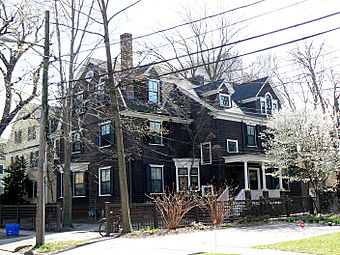William M. Davis House facts for kids
|
William Morris Davis House
|
|
|
U.S. Historic district
Contributing property |
|
 |
|
| Location | 17 Francis Avenue Cambridge, Massachusetts |
|---|---|
| Area | less than one acre |
| Built | pre 1898 |
| Architect | C Herbert McClare |
| Architectural style | Queen Anne |
| Part of | Shady Hill Historic District (ID86001680) |
| NRHP reference No. | 76000306 |
Quick facts for kids Significant dates |
|
| Added to NRHP | January 7, 1976 |
| Designated NHL | January 7, 1976 |
| Designated CP | May 19, 1986 |
The William Morris Davis House is a special old house located at 17 Francis Avenue in Cambridge, Massachusetts. It is recognized as a National Historic Landmark. This means it's an important place in American history. The house is famous because it was the home of William Morris Davis from 1898 to 1916. Davis was a very important professor at Harvard University. He made big contributions to how we understand weather and Earth's landforms.
Contents
Who Was William Morris Davis?
William Morris Davis (1850-1934) was a brilliant scientist. He taught geology at Harvard University. Geology is the study of Earth's physical structure and substances. Davis was a key person in developing two important science fields: meteorology and geomorphology.
What Did Davis Study?
- Meteorology: This is the study of Earth's atmosphere and weather. Davis wrote a textbook called Elementary Meteorology. For many years, it was the main book students used to learn about weather.
- Geomorphology: This field looks at how Earth's landforms are created and change over time. Davis helped shape this science.
Davis's Big Ideas
In 1912, Davis published a major work called A Reasoned Description of Landforms. In this book, he created a way to describe how landforms like mountains and valleys are formed. He also explained how they develop and how we can classify them around the world.
He also described the erosion cycle. This idea helps us understand how landforms change throughout their "life." Erosion is when wind, water, or ice wear away at the land. Davis's work helped scientists understand these processes much better.
About the House
The William Morris Davis House is a 2+1⁄2-story house made of wood. It was likely built in the 1890s. The house has an interesting design, which local historians call "Queen Anne-Shingle style."
House Features
- Shape: The main part of the house is almost square. It has a pointed roof called a gable roof.
- Front Section: There's a large section in front that matches the height of the main house. This part has a gambrel roof, which has two different slopes on each side.
- Entrance: The main door is on the side of the house. It's under a porch with round columns.
- Windows: The front of the house has a bay window, which sticks out from the wall. There's also a special window higher up called an oriel window.
- Exterior: The outside of the house is covered in shingles.
The house was made a National Historic Landmark in 1976. It's important because of the famous scientist who lived there.



